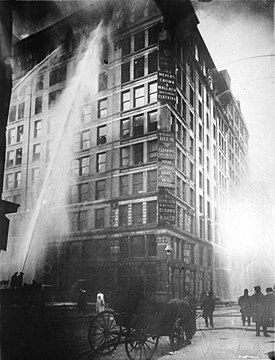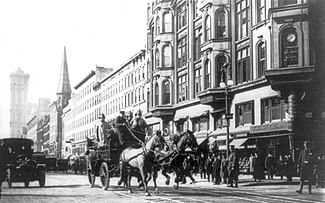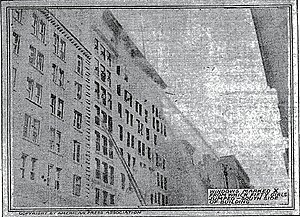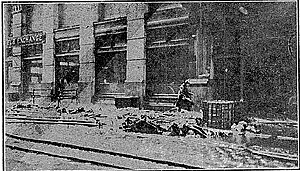Triangle Shirtwaist Factory fire
From Wikipedia, the free encyclopedia
 | |
| Time | 4:40 PM (Eastern Time) |
|---|---|
| Date | March 25, 1911 |
| Location | Asch Building, Manhattan, New York City, U.S. |
| Deaths | 146 |
| Injuries | 71 |
The Triangle Shirtwaist Factory fire in Manhattan, New York City on March 25, 1911 was the deadliest industrial disaster in the history of the city, and one of the deadliest in U.S. history. The fire caused the deaths of 146 garment workers – 123 women and 23 men [1] – who died from the fire, smoke inhalation, or falling or jumping to their deaths. Most of the victims were recent Jewish and Italian immigrant women aged 16 to 23;[2][3][4] of the victims whose ages are known, the oldest victim was Providenza Panno at 43, and the youngest were 14-year-olds Kate Leone and "Sara" Rosaria Maltese.[5]
Because the owners had locked the doors to the stairwells and exits, a common practice used to prevent workers from taking unauthorized breaks and pilferage,[6] many of the workers who could not escape the burning building jumped from the eighth, ninth, and tenth floors to the streets below. The fire led to legislation requiring improved factory safety standards and helped spur the growth of the International Ladies' Garment Workers' Union, which fought for better working conditions for sweatshop workers.
The factory was located in the Asch Building, at 23–29 Washington Place in the Greenwich Village neighborhood of Manhattan, now known as the Brown Building and part of New York University. The building has been designated a National Historic Landmark and a New York City landmark.[7]
Contents
[hide]Fire[edit]
The Triangle Waist Company[8] factory occupied the eighth, ninth, and tenth floors of the 10-story Asch Building on the northwest corner of Greene Street and Washington Place, just east of Washington Square Park, in the Greenwich Village area of New York City. Under the ownership of Max Blanck and Isaac Harris, the factory produced women's blouses, known as "shirtwaists." The factory normally employed about 500 workers, mostly young immigrant women, who worked nine hours a day on weekdays plus seven hours on Saturdays,[9] earning for their 52 hours of work between $7 and $12 a week,[6] the 2014 equivalent of $166 to $285 a week, or $3.20 to $5.50 per hour.[10]
As the workday was ending on the afternoon of Saturday, March 25, 1911, a fire flared up at approximately 4:40 PM in a scrap bin under one of the cutter's tables at the northeast corner of the eighth floor.[11] The first fire alarm was sent at 4:45 PM by a passerby on Washington Place who saw smoke coming from the eighth floor.[12]Both owners of the factory were in attendance and had invited their children to the factory on that afternoon.[13] The Fire Marshal concluded that the likely cause of the fire was the disposal of an unextinguished match or cigarette butt in the scrap bin, which held two months' worth of accumulated cuttings by the time of the fire.[14]Beneath the table in the wooden bin were hundreds of pounds of scraps which were left over from the several thousand shirtwaists that had been cut at that table. The scraps piled up from the last time the bin was emptied, coupled with the hanging fabrics that surrounded it; the steel trim was the only thing that was not highly flammable.[15] Although smoking was banned in the factory, cutters were known to sneak cigarettes, exhaling the smoke through their lapels to avoid detection.[16] A New York Times article suggested that the fire may have been started by the engines running the sewing machines, while The Insurance Monitor, a leading industry journal, suggested that the epidemic of fires among shirtwaist manufacturers was "fairly saturated with moral hazard."[13] No one suggested arson.[citation needed]
 |
|
| Problems playing this file? See media help. | |
A bookkeeper on the eighth floor was able to warn employees on the tenth floor via telephone, but there was no audible alarm and no way to contact staff on the ninth floor.[17] According to survivor Yetta Lubitz, the first warning of the fire on the ninth floor arrived at the same time as the fire itself.[18] Although the floor had a number of exits, including two freight elevators, a fire escape, and stairways down to Greene Street and Washington Place, flames prevented workers from descending the Greene Street stairway, and the door to the Washington Place stairway was locked to prevent theft by the workers; the locked doors allowed managers to check the women's purses.[19] The foreman who held the stairway door key had already escaped by another route.[20] Dozens of employees escaped the fire by going up the Greene Street stairway to the roof. Other survivors were able to jam themselves into the elevators while they continued to operate.[citation needed]
Within three minutes, the Greene Street stairway became unusable in both directions.[21] Terrified employees crowded onto the single exterior fire escape, which city officials had allowed Asch to erect instead of the required third staircase.[15] It was a flimsy and poorly anchored iron structure which may have been broken before the fire. It soon twisted and collapsed from the heat and overload, spilling about 20 victims nearly 100 feet (30 m) to their deaths on the concrete pavement below. Elevator operators Joseph Zito[22] and Gaspar Mortillalo saved many lives by traveling three times up to the ninth floor for passengers, but Mortillalo was eventually forced to give up when the rails of his elevator buckled under the heat. Some victims pried the elevator doors open and jumped into the empty shaft, trying to slide down the cables or to land on top of the car. The weight and impacts of these bodies warped the elevator car and made it impossible for Zito to make another attempt. William Gunn Shepard, a reporter at the tragedy, would say that “I learned a new sound that day, a sound more horrible than description can picture -- the thud of a speeding living body on a stone sidewalk ".[23]
A large crowd of bystanders gathered on the street, witnessing 62 people jumping or falling to their deaths from the burning building.[24] Louis Waldman, later a New York Socialist state assemblyman, described the scene years later:[25]
The remainder waited until smoke and fire overcame them. The fire department arrived quickly but was unable to stop the flames, as there were no ladders available that could reach beyond the sixth floor. The fallen bodies and falling victims also made it difficult for the fire department to approach the building.
Aftermath[edit]
Although early references of the death toll ranged from 141[26] to 148,[27] almost all modern references agree that 146 people died as a result of the fire: 123 women and 23 men.[28][29][30][31][32][33][34] Most victims died of burns, asphyxiation, blunt impact injuries, or a combination of the three.[35]
The first person to jump was a man, and another man was seen kissing a young woman at the window before they both jumped to their deaths.[36]
Bodies of the victims were taken to Charities Pier (also called Misery Lane), located at 26th street and the East River, for identification by friends and relatives.[citation needed]Victims were interred in sixteen different cemeteries.[28] Twenty-two victims of the fire were buried by the Hebrew Free Burial Association in a special section at Mount Richmond Cemetery. In some instances, their tombstones refer to the fire.[37] Six victims remained unidentified until 2011.[28][29] The six victims who remained unidentified were buried together in the Cemetery of the Evergreens in Brooklyn. Originally interred elsewhere on the grounds, their remains now lie beneath a monument to the tragedy, a large marble slab featuring a kneeling woman.[38] The six unknown victims were finally identified in February 2011[28] and a grave marker placed in their memory.[39]
Consequences and legacy[edit]
The company's owners, Max Blanck and Isaac Harris, who survived the fire by fleeing to the building's roof when the fire began, were indicted on charges of first- and second-degree manslaughter in mid-April; the pair's trial began on December 4, 1911.[40] Max Steuer, counsel for the defendants, managed to destroy the credibility of one of the survivors, Kate Alterman, by asking her to repeat her testimony a number of times, which she did without altering key phrases. Steuer argued to the jury that Alterman and possibly other witnesses had memorized their statements, and might even have been told what to say by the prosecutors. The prosecution charged that the owners knew the exit doors were locked at the time in question. The investigation found that the locks were intended to be locked during working hours based on the findings from the fire,[41] but the defense stressed that the prosecution failed to prove that the owners knew that. The jury acquitted the two men, but they lost a subsequent civil suit in 1913 in which plaintiffs won compensation in the amount of $75 per deceased victim. The insurance company paid Blanck and Harris about $60,000 more than the reported losses, or about $400 per casualty. In 1913, Blanck was once again arrested for locking the door in his factory during working hours. He was fined $20.[42]
Rose Schneiderman, a prominent socialist and union activist, gave a speech at the memorial meeting held in the Metropolitan Opera House on April 2, 1911, to an audience largely made up of the members of the Women's Trade Union League. She used the fire as an argument for factory workers to organize:
Others in the community, and in particular in the ILGWU,[44] drew a different lesson from events. In New York City, a Committee on Public Safety was formed, headed by Frances Perkins, a noted social worker, to identify specific problems and lobby for new legislation, such as the bill to grant workers shorter hours in a work week, known as the "54-hour Bill". The committee's representatives in Albany obtained the backing of Tammany Hall's Al Smith, the Majority Leader of the Assembly, and Robert F. Wagner, the Majority Leader of the Senate, and this collaboration of machine politicians and reformers – also known as "do-gooders" or "goo-goos" – got results, especially since Tammany's chief, Charles F. Murphy, realized the advantage to be had from being on the side of the angels.[6]
The New York State Legislature then created the Factory Investigating Commission to "investigate factory conditions in this and other cities and to report remedial measures of legislation to prevent hazard or loss of life among employees through fire, unsanitary conditions, and occupational diseases."[45] The Commission was chaired by Wagner and cochaired by Al Smith. They held a series of widely publicized investigations around the state, interviewing 222 witnesses and taking 3500 pages of testimony. They hired field agents to do on-site inspections of factories.They started with the issue of fire safety and moved on to broader issues of the risks of injury in the factory environment. Their findings led to thirty-eight new laws regulating labor in New York state, and gave each of them a reputation as leading progressive reformers working on behalf of the working class. In the process, they changed Tammany's reputation from mere corruption to progressive endeavors to help the workers.[46][47] New York City's Fire Chief John Kenlon told the investigators that his department had identified more than 200 factories where conditions made a fire like that at the Triangle Factory possible.[48] The State Commissions's reports helped modernize the state's labor laws, making New York State "one of the most progressive states in terms of labor reform."[49][50] New laws mandated better building access and egress, fireproofing requirements, the availability of fire extinguishers, the installation of alarm systems and automatic sprinklers, better eating and toilet facilities for workers, and limited the number of hours that women and children could work.[51] In the years from 1911 to 1913, sixty of the sixty-four new laws recommended by the Commission were legislated with the support of Governor William Sulzer.[6]
As a result of the fire, the American Society of Safety Engineers was founded in New York City on October 14, 1911.[52]
Remember the Triangle Fire Coalition[edit]
The Remember the Triangle Fire Coalition is an alliance of more than 200 organizations and individuals formed in 2008 to encourage and coordinate nationwide activities commemorating the centennial of the fire[53] and to create a permanent public art memorial to honor its victims.[54][55] The founding partners included Workers United, the New York City Fire Museum, New York University (the current owner of the building), Workmen's Circle, Museum at Eldridge Street, the Greenwich Village Society for Historic Preservation, the Lower East Side Tenement Museum, the Gotham Center for New York City History, the Bowery Poetry Club and others. Members of the Coalition include arts organizations, schools, workers’ rights groups, labor unions, human rights and women’s rights groups, ethnic organizations, historical preservation societies, activists, and scholars, as well as families of the victims and survivors.
The Coalition grew out of a public art project called "Chalk" created by New York City filmmaker Ruth Sergel.[56] Every year beginning in 2004, Sergel and volunteer artists went across New York City on the anniversary of the fire to inscribe in chalk the names, ages, and causes of death of the victims in front of their former homes, often including drawings of flowers, tombstones or a triangle.[53][57]
Centennial[edit]
From July 2009 through the weeks leading up to the 100th anniversary, the Coalition served as a clearinghouse to network some 200 activities as varied as academic conferences, films, theater performances, art shows, concerts, readings, awareness campaigns, walking tours, and parades that were held in and around New York City, and in cities across the nation, including San Francisco, Los Angeles, Chicago, Minneapolis, Boston and Washington, D.C.[53][53]
The ceremony, which was held in front of the building where the fire took place, was preceded by a march through Greenwich Village by thousands of people, some carrying shirtwaists – women's blouses – on poles, or wearing sashes commemorating the names of those who died in the fire. Speakers included the United States Secretary of Labor, Hilda L. Solis, U.S. Senator Charles Schumer, New York City Mayor Michael R. Bloomberg, the actor Danny Glover, and Suzanne Pred Bass, the grandniece of Rosie Weiner, a young woman killed in the blaze. Most of the speakers that day called for the strengthening of workers’ rights and organized labor.[58][59]
At 4:45 PM EST, the moment the first fire alarm was sounded in 1911, hundreds of bells rang out in cities and towns across the nation. For this commemorative act, the Remember the Triangle Fire Coalition organized hundreds of churches, schools, fire houses, and private individuals in the New York City region and across the nation. The Coalition maintains on its website a national map denoting each of the bells that rang that afternoon.[60]
Permanent memorial[edit]
The Coalition has launched an effort to create a permanent public art memorial for the Triangle Shirtwaist Factory fire at the site of 1911 fire in lower Manhattan. In 2012, the Coalition announced a national design competition for the memorial, and formed a design search committee, with representatives from Workers United, New York University, the New York City Fire Department, the Kheel Center for Labor-Management Documentation & Archives, Greenwich Village Society for Historic Preservation, Manhattan Community Board 2, family members of the victims, historians, and community members.[61][62]
In 2011, the Coalition established that the goal of the permanent memorial would be:
- To honor the memory of those who died from the fire;
- To affirm the dignity of all workers;
- To value women’s work;
- To remember the movement for worker safety and social justice stirred by this tragedy;
- To inspire future generations of activists
In popular culture[edit]
Films and television
- The Crime of Carelessness (1912), 14 minute Thomas A. Edison, Inc. short inspired by the Triangle Factory fire, directed by James Oppenheim[63]
- Children of Eve (1915), written and directed by John H. Collins[64]
- With These Hands (1950), directed by Jack Arnold[65]
- The Triangle Factory Fire Scandal (1979), directed by Mel Stuart, produced by Mel Brez and Ethel Brez[66]
- Those Who Know Don't Tell: The Ongoing Battle for Workers' Health (1990), produced by Abby Ginzberg, narrated by Studs Terkel[67]
- Episode 4 of Ric Burns' 1999 PBS series New York: A Documentary Film, "The Power and the People (1898–1918)", extensively covered the fire.
- The Living Century: Three Miracles (2001) premiered on PBS, focusing on the life of 107-year old Rose Freedman (died 2002), who became the last living survivor of the fire.
- American Experience: Triangle Fire (2011), documentary produced and directed by Jamila Wignot, narrated by Michael Murphy[68]
- Triangle Remembering the Fire (2011) premiered on HBO on March 21, four days short of the 100th anniversary.
- A door knob from the Triangle Shirtwaist Factory is an artifact in the TV series Warehouse 13, making an appearance in episodes "Past Imperfect" and "The 40th Floor" (2011).
Music
- "My Little Shirtwaist Fire" by Rasputina, from their 1996 album Thanks for the Ether.
- "The Triangle Fire" by The Brandos, from their 2006 album Over The Border.
- "Sweatshop Fire" by Curtis Eller, from his 2008 album Wirewalkers and Assassins.
Theatre and dance
- In Ain Gordon's play Birdseed Bundles (2000), the Triangle fire is a major dramatic engine of the story.[69]
- The musical Rags – book by Joseph Stein, lyrics by Stephen Schwartz, and music by Charles Strouse – incorporates the Triangle Shirtwaist fire in the second act.
- In March 2012, the modern dance concert One Hundred Forty-Six by Denise J. Murphy explored the Triangle Shirtwaist Factory fire through movement, text, video, photography and original music.[70]
Literature
- Margaret Peterson Haddix's 2007 historical novel for young adults, Uprising, deals with immigration, women's rights, and the labor movement, with the Triangle Shirtwaist Fire as a central element.
- Esther Friesner's Threads and Flames deals with a young girl, named Raisa, who works at the Triangle Shirtwaist Factory at the time of the fire.
- Deborah Hopkinson's 2004 historical novel for young adults, Hear My Sorrow: The Diary of Angela Denoto.
- Mary Jane Auch's 2004 historical novel for young adults, Ashes of Roses tells the tale of Margaret Rose Nolan, a young girl who works at the Triangle Shirtwaist Factory at the time of the fire, along with her sister and her friends.
- The comic book The Goon issue #37 tells the story of a similar fire at a girdle factory that takes the lives of 142 women who worked there. After the fire, the surviving women attempt to unionize and the Goon comes to their aid after union busters try to force them back to work. Author Eric Powell specifically cites the Triangle Shirtwaist Factory fire as an inspiration for the story.
- Vivian Schurfranz's novel Rachel, from the Sunfire series of historical romances for young adults, is about a Polish Jewish immigrant girl who works at the Triangle Shirtwaist Factory at the time of the fire.
- In issue #28 of the comic " The Dreaming", The Triangle Shirtwaist Factory (and the fire specifically) is featured heavily.
- Robert Pinsky's poem Shirt describes the fire.
- "Mayn Rue Platz" (My Resting Place), a poem written by former Triangle employee Morris Rosenfeld, has been set to music, in Yiddish and English, by many artists, including Geoff Berner and June Tabor.
- In Alice Hoffman's novel "The Museum of Extraordinary Things", the fire is one of the main elements of the plot.
- "Afterlife" a 2013 short story by Stephen King centers around Isaac Harris being in Purgatory and talking about the fire.
- Triangle, a 2006 novel by Katharine Weber, is based around the questionable testimony of a key witness, and incorporates parts of the court transcript
See also[edit]
- 2012 Dhaka fire, a similar fire in a garment factory in Bangladesh
- 2013 Savar building collapse – the deadliest garment-factory accident in history
- International Women's Day
- Occupational Safety and Health Administration
- Rhinelander Waldo, N.Y.C. Fire Commissioner in 1911










No comments:
Post a Comment
Please leave a comment-- or suggestions, particularly of topics and places you'd like to see covered